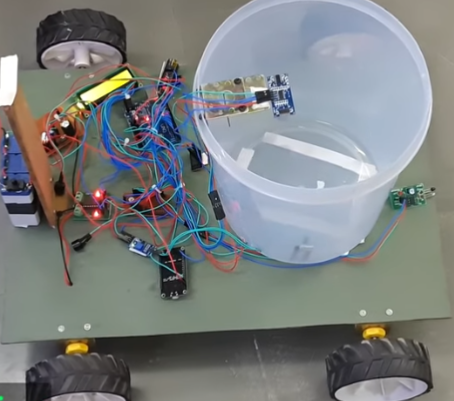A Smart Garbage Monitoring System using IoT is a project designed to efficiently manage waste collection using smart sensors and Internet of Things (IoT) technology. The system monitors the fill levels of garbage bins and optimizes waste collection schedules to reduce overflow and unnecessary trips.

🔹 Project Overview
The system consists of:
- Smart Sensors (e.g., ultrasonic, infrared, or weight sensors) to detect the fill level of bins.
- Microcontroller (e.g., Arduino, ESP8266, Raspberry Pi) to process sensor data.
- Wireless Communication (e.g., Wi-Fi, GSM, LoRa, or Zigbee) to transmit data to a central server.
- Cloud-Based Dashboard or a Mobile App for real-time monitoring and alerts.
- Automated Alerts & Notifications to inform waste collection teams.
🔹 Working Principle
- Sensing the Fill Level
- Ultrasonic or infrared sensors measure the garbage level inside the bin.
- Data Processing & Transmission
- A microcontroller collects data and sends it via Wi-Fi/GSM to a cloud server or database.
- Real-Time Monitoring
- The cloud-based system displays garbage bin status on a dashboard or app.
- Alerts & Notifications
- If a bin reaches a predefined threshold (e.g., 80% full), an alert is sent to waste management teams.
- Optimized Collection Route
- AI or algorithms suggest the most efficient route for garbage collection based on bin status.
🔹 Hardware Requirements
- Microcontroller (Arduino, ESP8266, ESP32, or Raspberry Pi)
- Ultrasonic Sensors (HC-SR04) or IR Sensors for fill level detection
- Wi-Fi Module (ESP8266) or GSM Module (SIM800L) for connectivity
- Battery or Solar Power Source (for remote locations)
- GPS Module (optional, for tracking bin location)
- LCD Display / LED Indicator (optional, for local status display)
🔹 Software Requirements
- Arduino IDE (for programming the microcontroller)
- Blynk / Firebase / ThingSpeak (for IoT dashboard)
- MQTT Protocol (for real-time messaging)
- Mobile App or Web Dashboard (for monitoring and alerts)
- Python / Node.js (for server-side processing)
🔹 Benefits
✅ Optimized Waste Collection – Reduces fuel costs and labor.
✅ Prevents Overflow – Helps in maintaining cleaner surroundings.
✅ Data-Driven Insights – Helps municipalities plan waste management better.
✅ Eco-Friendly – Reduces CO₂ emissions from garbage trucks.
✅ Cost-Effective – Saves resources by reducing unnecessary collections.

